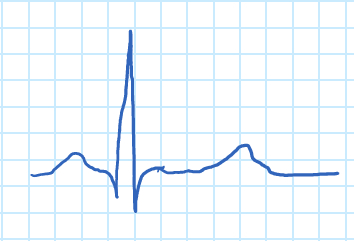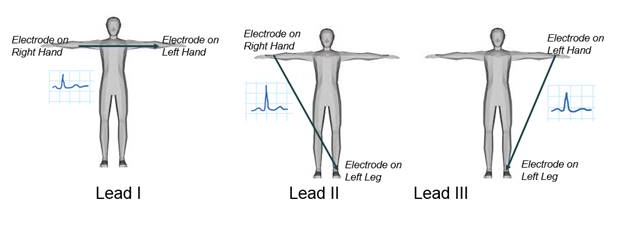心電図(心電図)信号の獲得と解析
English
分享
概述
出典:ペイマン・シャーベイギ・ルードポシュティとシナ・シャーバズモハマディ、バイオメディカル工学部、コネチカット大学、ストールズ、コネチカット州
心電計は、心臓活動を実証するために患者の胴体に置かれた電極間で起こる電位変化によって記録されたグラフである。心電図信号は、心臓のリズムと心臓への血流の悪さや構造的な異常など、多くの心臓病を追跡します。心臓壁の収縮によって生じる作用電位は、心臓からの電流を全身に広げる。広がる電流は、皮膚に配置された電極によって感知することができる体内の点で異なる電位を作成します。電極は、金属と塩で作られた生物学的トランスデューサです。実際には、10個の電極が本体上の異なる点に取り付けられています。心電図信号を取得して分析するための標準的な手順があります。健康な個人の典型的な心電図波は次のとおりです。

図 1.心電図波。
「P」波は心房収縮に相当し、心室の収縮に「QRS」複合体を表す。「QRS」複合体は、心房および心室の筋肉量の相対的な発散による「P」波よりもはるかに大きく、心房の弛緩を隠す。心室の弛緩は「T」波の形で見ることができる。
図 2 に示すように、腕と脚の電位差を測定する主なリードは 3 つあります。このデモンストレーションでは、四肢リードの1つであるリードIが調べられ、2本の腕間の電位差が記録されます。すべての心電図リード測定と同様に、右脚に接続された電極は接地節点とみなされます。心電図信号は、生体電位増幅器を使用して取得し、計測ソフトウェアを使用して表示され、振幅を調整するためにゲイン制御が作成されます。最後に、記録された心電図が分析されます。

図 2.心電図リムリード。
Principles
心電計は、0.5mV~5.0mVの非常に弱い信号だけでなく、最大±300mV(電極皮膚接触に起因する)の直流成分と最大1.5Vのコモンモード成分を検出できる必要があります。電極と地面の間。心電図信号の有用な帯域幅は、アプリケーションに依存し、0.5〜100 Hzの範囲で、時には1 kHzまで達することができます。これは、一般的に、はるかに大きな外部高周ノイズ、50または60 Hz干渉、およびDC電極オフセット電位の存在下でピーク対ピークの周りにあります。その他のノイズ源としては、皮膚電極界面に影響を与える動き、筋肉の収縮や筋電図スパイク、呼吸(リズミカルまたは散発性の可能性がある)、電磁干渉(EMI)、その他の電子機器からのノイズなどがあります。そのカップルを入力に入れた。
まず、心電図を処理する生体電位増幅器を生成する。次いで、電極を患者に配置し、2本の腕間の電位差を測定する。生体電位増幅器の主な機能は、生体起源の弱い電気信号を取り、さらに処理、記録、または表示できるように振幅を増加することです。

図 3.心電図アンプ。
生物学的に有用な場合、すべての生体電位アンプは、特定の基本的な要件を満たす必要があります。
- 測定される信号の負荷を最小限に抑えるように、高い入力インピーダンスを持つ必要があります。バイオポテンシャル電極は、その負荷の影響を受け、信号の歪みにつながる可能性があります。
- 生体電位増幅器の入力回路はまた、研究対象に保護を提供する必要があります。アンプは、電極回路を通る電流を安全なレベルに保つことができるように、絶縁および保護回路を持っている必要があります。
- 出力回路は負荷を駆動し、これは通常、示す装置または記録装置である。読み出しで最大の忠実度と範囲を得るには、アンプは低出力インピーダンスを持ち、負荷に必要な電力を供給できる必要があります。
- 生体電位増幅器は、増幅する生体電位が存在する周波数スペクトルで動作する必要があります。このような信号のレベルが低いため、アンプの帯域幅を制限して、最適な信号対雑音比を得ることが重要です。これは、フィルターを使用して行うことができます。
図3は心電図増幅器の一例であり、図4は、このデモで構築された心電図増幅器の回路である。保護回路、計装アンプ、ハイパスフィルタの3つの主要なステージがあります。

図 4.生体電位増幅器。
第1段階は患者保護回路である。ダイオードは一方向に電流を流す半導体デバイスです。ダイオードが前方バイアスされると、ダイオードは短絡として機能し、電気を伝導します。ダイオードが逆バイアスされている場合、それは開回路として機能し、電気を伝導しない、私は0を行います。
ダイオードが順方向バイアス構成にある場合、ダイオードが電流を流すためには、閾値電圧(VT = 約0.7V)を超えなければならない電圧があります。VTを超えると、ダイオード全体の電圧降下は、Vが何であるかに関係なく、VTで一定に保たれます。
ダイオードが逆バイアスされている場合、ダイオードは開回路上で動作し、ダイオード全体の電圧降下はVに等しくなります。
図5は、このデモで使用されるダイオードに基づく単純な保護回路の一例です。抵抗器は患者を通して流れる電流を制限するために使用される。計装アンプまたはダイオードの障害が患者といずれかのパワーレールとの短絡の場合、電流は0.11 mA未満になります。FDH333低漏れダイオードは、計装アンプの入力を保護するために使用されます。回路内の電圧が0.8Vを超えると、ダイオードはアクティブ領域または「ON」状態に変化します。電流はそれらを流れ、患者および電子部品の両方を保護する。

図 5.保護回路。
第2段階は、3つのオペアンプ(オペアンプ)を使用する計装アンプIAです。入力抵抗を高めるために、各入力に1つのオペアンプが取り付けられています。3番目のオペアンプは差動アンプです。この構成は、地上参照干渉を拒否し、入力信号間の差を増幅するだけの能力を有する。

図 6.計装アンプ。
第3段階は、大きな直流電圧の上に乗る小さなAC電圧を増幅するために使用されるハイパスフィルタです。心電図は、患者の動きと呼吸から来る低周波信号の影響を受けます。ハイパスフィルタは、このノイズを低減します。
高いパスフィルタは、一次RC回路で実現できます。図 7 は、1 次ハイパス フィルターとその転送関数の例を示しています。カットオフ周波数は、次の式で示されます。
 ,
,



図 7.ハイパスフィルタ。
Procedure
Results
In this demonstration, three electrodes were connected to an individual, and the output passed through a biopotential amplifier. A sample ECG graph prior to digital filtering is shown below (Figure 8).

Figure 8. ECG signal without digital filtering.
After designing the filters and feeding the data to the developed algorithm, the peaks on the graph were detected and used to calculate heart beat rate (BPM). Figure 9 displays the raw data an ECG signal (before any filtering) in time and frequency domain. Figure 10 shows the result of filtering that signal.

Figure 9. ECG signal before filtering.

Figure 10. Filtered ECG signal.
The original ECG plot had slightly visible P, QRS, and T complexes that presented many fluctuations from the noise. The spectrum of the ECG signal also showed a clear spike at 65 Hz, which was assumed to be noise. When the signal was processed using a low-pass filter to remove extraneous high frequency portions and then a band-stop filter to remove the 65 Hz signal component, the output appeared significantly cleaner. The ECG shows each component of the signal clearly with all noise removed.
In addition, the measured heart rate was approximately 61.8609 beats per minute.
Applications and Summary
Contraction of cardiac muscle during the heart cycle produces electric currents within the thorax. Voltage drops across resistive tissue are detected by electrodes placed on the skin and recorded by an electrocardiograph. Since the voltage is weak, in the range of 0.5 mV, and small compared to the magnitude of noise, processing and filtering the signal is necessary. In this experiment, an electrocardiograph device consisting of a two part analog and digital signal processing circuit was designed to analyzing the resulting ECG signal, and calculate the heartbeat rate.
This demonstration introduced the fundamentals of electronic circuitry and filtering of ECG signals. Here, practical signal processing techniques were used to extract a weak signal from a noisy background. These techniques can be used in other similar applications where signal amplification and noise reduction is required.
Materials List
| Name | Company | Catalog Number | Comments |
| Equipment | |||
| Power supply | B&K Precision | 1760A | |
| Multimeter | |||
| Oscilloscope | |||
| Proto-board | |||
| 4 FDH333 diodes | |||
| 1 AD620 | |||
| 3 47kΩ resistor | |||
| 2 100nF capacitors | |||
| 3 ECG electrodes | |||
| Several alligator clips and Tektronix probe. |
成績單
Electrocardiographs record cardiac activity of the heart and are used to diagnose disease, detect abnormalities, and learn about overall heart function. Electrical signals are produced by contractions in the heart walls which drive electrical currents and create different potentials throughout the body. By placing electrodes on the skin, one can detect and record this electrical activity in an ECG. ECGs are non-invasive, making them a useful tool to assess how well a patients heart is performing, such as by measuring how well blood flows to the organ.
This video will illustrate the principals of ECGs and demonstrate how to acquire, process, and analyze a typical ECG signal using a biopotential amplifier. Other biomedical applications that utilize electrical signal processing to diagnose disease will also be discussed.
To understand the principles of an ECG, let’s first understand how the heart produces electrical signals. For a normal, healthy heart, at rest, an ECG displays a series of waves that reflect the different phases of a heartbeat. The ECG starts in the sinoatrial node, also known as the SA node, which is located in the right atrium and acts as a pacemaker in the heart. The electrical signals cause atrial contraction forcing blood into the ventricles. This sequence is recorded as the P wave on the ECG. This signal then passes from the atria across the ventricles, causing them to contract and pump blood to the rest of the body. This is recorded as the QRS complex.
Finally, the ventricles relax and this is recorded as the T wave. The process then begins again and is repeated for every heartbeat. Notice that the QRS wave is much larger than the P wave, this is because the ventricles are larger than the atria. Meaning they mask the relaxation of the atria or the T wave. Other processes in the body, like respiration or muscle contractions, can interfere with the ECG measurement. As can currents from the circuitry used to obtain them. Often, the electrical signals that the ECG is attempting to record are quite weak. Therefor, a biopotential amplifier is used to increase their amplitude which allows them to be further processed and recorded.
There are three main components to the biopotential amplifier, the patient protection stage, the instrumentation amplifier, and the high pass filter. As the main suggests, the patient protection circuit uses a combination of resistors and diodes to protect, both, the patient and the machine and equipment. The resistors limit the current that flows through the patient, where as the diodes keep the current flowing in the correct direction.
The next stage is the instrumentation amplifier, which amplifies the difference between the inputs from each electrode. It is composed of three operational amplifiers. Two to increase the resistance from each input, and the third to amplify the difference between the input signals.
The last stage is the high pass filter, which reduces the noise and filters out low frequency signals arising from patient movement or respiration. Now that you know how an ECG is measured, let’s see how to construct a biopotential amplifier and process the data to get a clean ECG signal.
Having reviewed the main principals of electrocardiography, let’s see how to build a biopotential amplifier and acquire an ECG signal. To begin, first gather a proto-board, an AD-620 instrumentation amplifier, and all necessary circuit components. Then, calculate the values of all of the resistors and capacitors in the circuit using the following equation.
For the high pass filter, the cut off frequency should be 0.5 hertz.
Then, plug in the capacitor value to determine the resistance. Next, build a biopotential amplifier according to the provided diagram. Here is what the final circuit should look like. Attach three wires with alligator clips to the binding posts of a DC power supply, then turn on the power source. Adjust the voltage to plus five volts and minus five volts, and connect the the wires, in series, to the circuit.
Now, use an alcohol prep pad to wipe the patients right wrist, left wrist, and right ankle. Add conductive adhesive gel to the electrodes before placing them on the patient. Then, connect the electrodes to the circuit using wires with alligator clips. Turn on the oscilloscope and acquire the ECG signal. Adjust the horizontal and vertical scales as needed. With these adjustments, you should be able to see the R peak of the wave form.
Connect the circuit to the PXI chassis, then open the instrumentation software and, either, use or write a program that will display the ECG signal and a wave form graph.
Configure the data acquisition interface with the following settings. Label the scale of the x-axis to display time and seconds, then display the ECG signal as a waveform. If the signal needs to be amplified, create a gain control and set it so that the amplitude of the ECG is two VP.
Now that we have demonstrated how to acquire an ECG signal, let’s see how to analyze the results. Here is a representative ECG signal. The P, QRS, and T waves are barely discernible because they are obscured by noise and fluctuations. This signal needs to be filtered. To transform this signal, first, select Signal Processing then Spectral on the menu. A Fast Fourier Transform algorithm calculates and plots the spectrum of the signal displaying the frequency as discreet values on the horizontal axis. Most of the energy in the signal is at low frequencies.
But, there is a high intensity peak in the medium frequency range, which is assumed to be noise. Frequency is plotted as k on the horizontal axis and goes from zero to N minus one over two, where N is the length of the sequence. For this experiment, N equals 2,000. Calculate the analog frequency for each k value using the following equation, where f s is the sampling frequency and determine the frequency of the high intensity peak based on the FFT graph.
Then, create a low pass filter with a cutoff frequency of 100 hertz. Use, either, the Butterworth or Chebyshev function to filter the signal, which should attenuate at least 60 decibels per decade in the stop band. Connect the output signal of the data sub VI to the input of the low pass filter. This filter removes the extraneous high frequency waves of the ECG. Now, create a Bandstop filter and set the cutoff frequencies at around 55 and 70 hertz.
To remove the noisy signal, around 60 hertz. Then, connect the output of the low pass filter to the input of the Bandstop filter. Try border frequencies that are close to 60 hertz. This will reduce interference without effecting other frequencies. The ECG signal should now be clear with distinct P, QRS, and T complexes.
Now, let’s determine the heart rate using the filtered ECG signal. First, use the peak detector sub VI to find the peaks of the signal. Choose the most appropriate value based on the signals amplitude of the R wave for the threshold. Then, use the Index Array sub VI to determine the location of the peaks.
Subtract the lower peak position from the higher position, then multiply this value by the sampling period, T, which is equal to one over f s. This value is the length of time between two R waves. Adjust the units to determine the beats per minute.
In this demonstration, the measured heart rate was approximately 60 beats per minute.
ECG and signal processing have important applications in, both, medicine and research. In addition to being non-invasive, ECGs are relatively inexpensive. Making it a useful and accessible tool in hospitals. ECGs can even be adapted to more complex and longterm monitoring of patients who are being treated for Acute Coronary Syndrome.
For this, 12 ECG leads are used, which can identify transient myocardial ischemia in asymptomatic patients. Signal sampling and processing is also used in electroencephalography to measure electrical signals from the brain. EEGs are commonly used in conjunction with functional MRI as a multimodal imaging technique.
The method noninvasively generates cortical maps of brain activity for many neuroimaging applications, such as after visual or motor activation.
You’ve just watched Jove’s introduction to acquiring and analyzing ECG signals. You should now understand how an ECG signal is produced and how to create a biopotential amplifier to detect weak electrical signals. You have also seen some biomedical applications of signal processing for medical diagnosis.
Thanks for watching.
